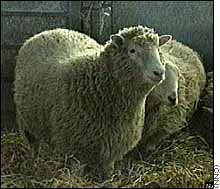Snapshot on Dolly the sheep's fifth birthday

The newspapers of the world celebrated the fifth birthday of Dolly the cloned sheep last week. But the years that have passed since Dolly stirred the spirits have not redeemed her from her loneliness.
Despite huge budgets, lengthy research and dozens of attempts, the overwhelming majority of cloning efforts still end in nothing. Even when a fetus eventually develops, in many cases it dies during pregnancy. Even in those few cases where the cloning attempt ends in a successful birth, there are many chances that the child will suffer from strange syndromes and will not live out his days. Dolly, the pioneer of successful cloning, is still one of the only cloned mammals to have a birthday.
A study published this week offers an explanation for the cloning failures. At the same time, the new study allows a glimpse into the way in which the cells of the developing fetus read the genes transferred from both parents.
Each cell of the body contains two copies of each gene - one from each parent. But sometimes two different copies, trying to perform the same function at the same time, can cause fatal errors. Therefore, in many cases one of the copies is "silenced", a situation that causes the cell to ignore it.
But duplicating is not the only problem. Sometimes even one copy is too many. A brain cell, for example, will never need even one of the copies of the genes responsible for determining eye color, and a skin cell in the foot does not need a gene that produces insulin. These irrelevant genes are also silenced.
Geneticists studying the silencing mechanisms discovered interesting phenomena. There are, for example, genes that are always transmitted through maternal inheritance. That is, the gene that comes from the mother is active, while the copy that comes from the father is always silenced. In other genes the inheritance is paternal. Geneticists call this phenomenon imprinting. The gene carries a mark on it that tells the cell whether it is a maternal or paternal gene. This sign is what "turns off" or "turns on" the garden.
What happens in a cloned animal? The logic says that the cloned creature receives the imprinting pattern that appeared in the genome from which it was duplicated. Therefore two cloned creatures should be expected to have the same signature pattern. The new study tested this hypothesis.
The researchers, led by David Humphreys of the Massachusetts Institute of Technology, cloned mice and tested their imprinting patterns in relation to the cells from which they were taken. It turned out that the cloned mice, which as expected suffered from various syndromes, lost the parental imprinting patterns. The genes forgot where they came from and did not provide the cells with the information needed to silence the correct gene. In each of the mice, which are supposed to be identical twins, a different copy of the genes tested by the Paris and his team was silenced.
The gene silencing regimen is a necessary condition for normal development. This way each cell can know which genes it should use and which it should ignore. The work of Humphreys and his partners, published this week in the journal "Science" raises the concern that in cloned animals this silencing regime is going wrong. It is possible that this malfunction causes the variety of illnesses and deformities that the clones suffer from. It is possible, the researchers write, that even in those few cloned mammals that look normal there are "subtle genetic deviations" hidden.
The imprinting mechanisms and silencing systems are a hot topic in molecular biology, a field in which there are still many open questions. Therefore, it is not surprising that the research methods of Hemphreys and his partners, as well as the conclusions they drew from the experiment, were attacked by experts from various fields. Alan Coleman, the director of the laboratory that cloned Dolly, claimed this week that the research in mice does not teach anything about sheep or pigs. Dolly's father also took the opportunity to criticize the research methods used by the Parisian and his men.
But not everyone participates in the theoretical debate. This polemic does not concern, for example, the Clonoid company, which announced last week to the press that "very soon" it will implement the plan to clone a human baby. Ultimately, many scientists are convinced that there will be no technological impediment to a human race. Many even put a lot of hope in this possibility in the fields of medicine. But for now, almost all experts agree that the immature stage of cloning technologies, and the partial understanding of the processes that underlie them, require caution. Prof. Ian Wilmot, a senior member of the team that cloned Dolly, told the BBC this week: "The most likely result of any cloning attempt is abortion, and possibly the birth of babies who will die at a very young age." But the fear that Wilmot defined as "the worst of all" is that those abnormal children will live long lives with different diseases and syndromes.
